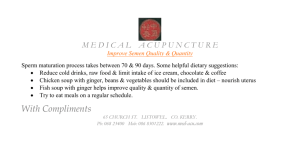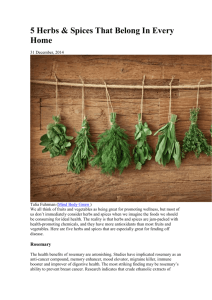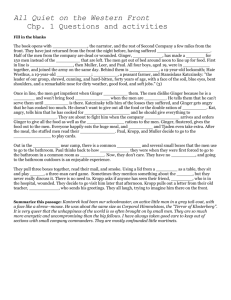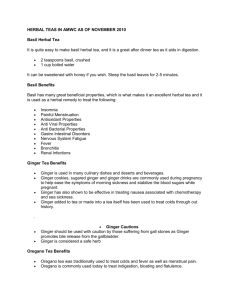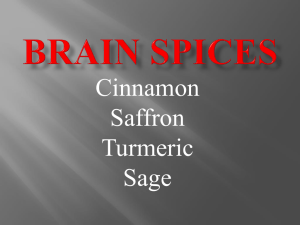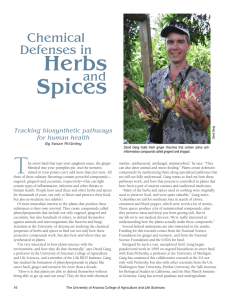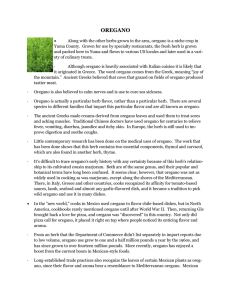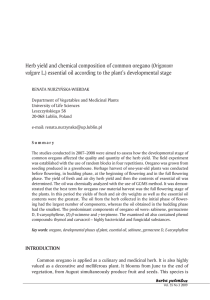Spice Up Your Health Healthy Herbs & Super
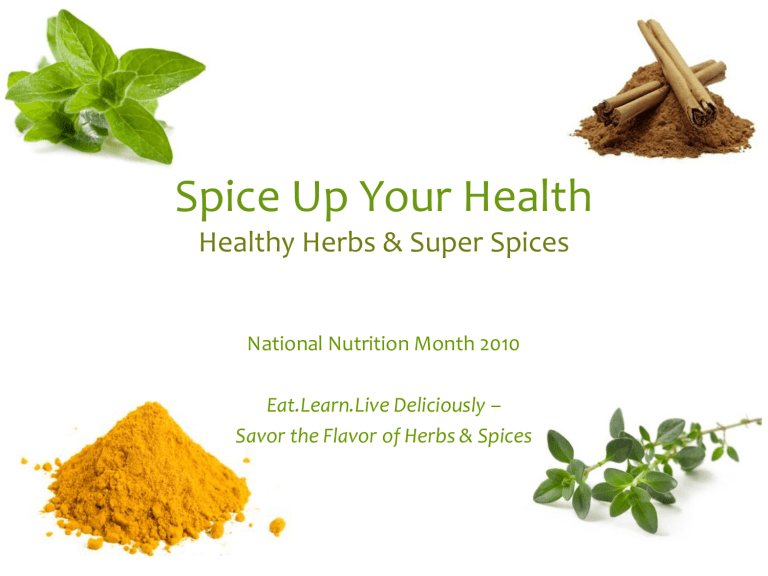
Spice Up Your Health
Healthy Herbs & Super Spices
National Nutrition Month 2010
Eat.Learn.Live Deliciously –
Savor the Flavor of Herbs & Spices
Objectives
• Identify common herbs & spices and their health or healing properties.
• Name the 7 Super Spices.
• Determine one way to add a healthy herb or spice to your current eating habits.
More Than Just a Garnish
• Fresh and flavorful cooking
• Natural health remedy
– Examples:
• Ginger used for nausea
• Parsley used for fresh breath
• Packed with nutrition
Oregano
• “Mini-salad” in a spoon
• Significant source of vitamin K
• Strong antibacterial agent
• High in antioxidants
• Pair oregano with:
– peppers, tomatoes, mushrooms, salads
– dressings, olive oil and breads
– chicken, lamb, egg dishes
Basil
• Significant source of vitamin K
• Fights inflammation
• Strong antibacterial agent
• Promotes heart health
• Basil complements:
– Tomatoes, garlic, olive oil, vinegars, nuts
– Peppers, squash, eggplant, mushrooms
– Poultry and fish
Thyme
• Significant source of vitamin K
• Thymol relieves cough, congestion
• Powerful antimicrobial, antifungal agent
• Natural food preservative
• Uses for thyme:
– Season soups, sauces, broths and stock
– Season kidney beans, pinto beans and black beans
– Omelets, frittatas, fish and other meats
Rosemary
• Good source of fiber, iron and calcium
• May kill cancer cells
• Fights free radical damage in the brain
• Improves digestion & circulation
• Stimulates the immune system
• Rosemary pairs well with:
– Chicken, lamb, pork, salmon, tuna
– Soups, sauces, add to dipping oils
– Omelets and frittatas
Do you remember?
• What herb contains so many nutrients that its nickname is “mini-salad”?
• What herb contains the active ingredient in many vapor rubs used to treat colds?
• What herb protects the brain?
• BONUS: What do oregano, basil and thyme have in common?
McCormick’s 7 Super Spices
1. Oregano
2. Rosemary
3. Thyme
4. Cinnamon
5. Ginger
6. Red Pepper
7. Yellow Curry (Turmeric) http://www.mccormick.com/SpicesForHealth/SevenSuperSpices.aspx
Cinnamon
• Significant source of manganese
• Very good source of fiber, iron & calcium
• Essential oils
– Anti-inflammatory properties
– Anti-clotting actions
– Antimicrobial, natural food preservative
• Regulates blood sugar levels
Khan A, et al, Diabetes Care Dec 2003
Cinnamon
• Sweet
– French toast, pancakes, waffles
– Baked goods, fruit cobblers, yogurt
– Chai tea, milk, hot chocolate
• Savory
– Soups, stews, chilis and meat dishes
– Vegetables, curries, grains/couscous
Ginger
• Good source of potassium, magnesium, copper, manganese and vitamin B6
• Remedy for motion sickness, nausea, vomiting
• Anti-inflammatory properties
• Boosts immune system
Ginger
• Natural Remedy
– Nausea: Steep 2 ½ ” slices fresh ginger root in hot water
– Arthritis: Eat minimum of ¼ ” slice fresh ginger cooked in food
• Enjoy Ginger in:
– Sweet potatoes, baked apples, breads, cookies
– Stir-frys, vegetables, salad dressings, slaws, Ginger lemonade, teas
Do you remember?
• What spice has the highest antioxidant capacity of any spice?
• What herb is a remedy for nausea?
• Can you name 4 of the 7 super spices?
Red Pepper
• Significant source of vitamin A
• Capsaicin creates
“heat”
– Clears congestion
– May boost metabolism
– Controls appetite
• Fights inflammation
• Cardiovascular benefits
• Ways to enjoy:
– In the pepper mill
– On pizza, breads
– Vegetable sautés
– Greens
– Pasta sauces
– On fresh fruit
– Hot chocolate
Turmeric
• Significant source of manganese and iron
• Anti-inflammatory properties
• May inhibit cancer cell growth
• May protect brain
• Use turmeric in:
– Rice & curry dishes, lentils, cauliflower
– Dips, salad dressings, egg salads
Do you remember?
• Which spice may help you eat fewer calories and boost your metabolism?
• Which spice may protect against Alzheimer’s disease and prostate cancer?
Conclusion
8 Healthy Herbs & Super Spices
1. Oregano 5. Cinnamon
2. Rosemary 6. Ginger
3. Thyme 7. Red Pepper
4. Basil 8. Turmeric


